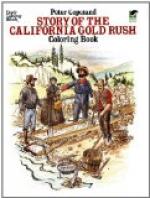[Illustration: “EL CAPITAN” (3300 feet in height).]
[Illustration: YOSEMITE FALLS.]
In mountain regions, above five or six thousand feet, the very cold winter lasts six or seven months. Snow falls almost constantly and drifts to a great depth. Small lakes are frozen and buried in snow, and the trees are bent and weighed down with ice and sleet. Many of the wild animals come down to the foot-hills below the snow-line to spend the winter; but the bear curls himself up in his warm cave and sleeps through the cold months. In this snowy zone of the Sierras, about thirty miles wide, winter lasts from the first snowfall, about the end of October, to the late spring of June. Then July and August are months of glorious weather, with clear, dry air and a cloudless sky. During the day the temperature of about 80 degrees melts much snow, and the rivers carry it away in rushing torrents and falls of icy water. In September the frost turns the leaves of all but the evergreen trees beautiful colors of red and yellow. Indian summer comes during September and October, when the days are sunny and warm, and then the long winter sets in again. Peaks above eight thousand feet are snow-clad on their crests and along their sides by deep drifts the year round.
Along the Pacific coast in summer cool sea-winds, called trade-winds, blow in from the ocean, and 60 degrees is the average temperature. The farther you go inland from the coast, the hotter it gets, and the heat is very great in the interior of the state. In the San Joaquin and Sacramento valleys it is often over 100 degrees in the shade, though this dry heat is not hard to bear, and the nights are always cool enough for one to sleep in comfort.
Summer fogs are usual in the coast counties. The mornings are pleasant and sunny till about eleven o’clock. At this time the sun’s rays grow stronger in the interior valleys, and the hot air rises while trade-winds rush in from the cold ocean and fog settles down like a thick, gray cloud over the bay and hills. July and August are cold and foggy along the coastline, with strong west winds almost every day. In September the winds die away, and sometimes a shower or two falls.
The rainless desert, or southeastern corner of our state, is the hottest region of all. Here the sun glares down till sand and rocks seem heated by a fiery furnace. Every living creature gasps and pants for breath in the scorching heat. There are no trees, but only cactus, that queer, prickly, thorny plant, often fifteen or twenty feet high in these wastes of sand, and low greasewood bushes. Under this vegetation snakes, lizards, and horned toads bask all day and search for food at night. If travellers wander from the road in crossing the desert, they are easily lost, and sometimes they die or go mad in the terrible heat. There are no springs, and water stations are a long way apart, so that lost people usually die of thirst. As the heat of the sun’s rays quivers over the burning sands, a curious sight called a mirage is often produced. A cool, glassy lake or flowing river bordered with green trees seems pictured in the air, and the hot and weary traveller can scarcely believe that only sand and rocks are before him.




